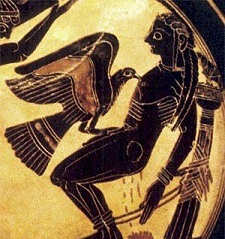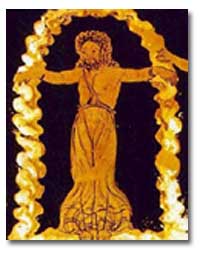 |
| Prometheus chained to a cliff in the Caucasus. This is a more modern depiction, or at least resembles it. Source: not known. |
One thing about impalement that the Ancient Greeks knew that modern scholars (at those who have studied the topic of "crucifixion") don't seem to get, is that the executioners could run a stake right through a man and he would end up in the extended struggle of a slow, lingering death. Their knowledge of this can be clearly seen both in the epigraphy and the (ableit very rare) extant writings.
First, I have found various epigraphy of Prometheus fastened to some kind of stake, or frame, or "crucified" by being chained to a cliff face.
Here are two images showing Prometheus attached to a stake.
Here we see Herakles freeing the bound Prometheus from the stake just as the appointed eagle arrives to torment him.
 |
| Herakles freeing Prometheus. Attic black-figure cup, c. 500 BCE Source: Bibi Saint-Pol, Wikimedia Commons. |
 |
| Early depiction of Prometheus bound to a pillar. Laconian black-figure amphoriskos 6th C. BCE. Source: Vatican City Museums, Theoi.com. |
In this image below, Prometheus is depicted as "crucified" though with bent elbows to a cliff. he's standing on his tip-toes and his feet appear to overlap each other, like those of "Jesus" on the Shroud of Turin. This image is clearly congruent with the imagery depicted in Lucian's Prometheus, and it may be where Lucian got his ideas of how the god was allegedly hanged.
 |
| Heracles freeing Prometheus, who is "crucified" to a cliff. Relief from the Sebasteion at Aphrodisias.1st C. CE. Source: Source: Hans Weingartz, Deutsch (German) Wikipedia. |
 |
| Depiction of Prometheus on a vase ca 350 bce. Source: unknown. |
But the next two depict (or at least imply) Prometheus as impaled.
 |
| Early depiction of Prometheus impaled on a stake. Note the stake is absurdly flat-topped! Black-and-white line drawing copy. Source: not known. |
 |
| Another early depiction from a plate or vase of Prometheus impaled on a stake. Again, the impaling stake is flat-topped. Source: Theoi.com. |
Textual evidence later.
No comments:
Post a Comment